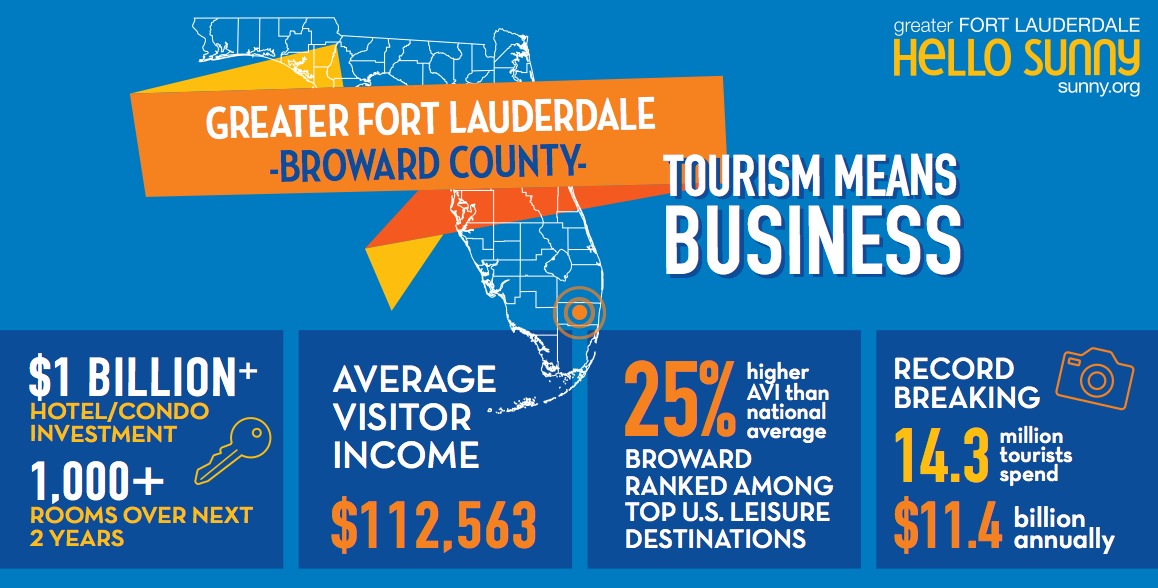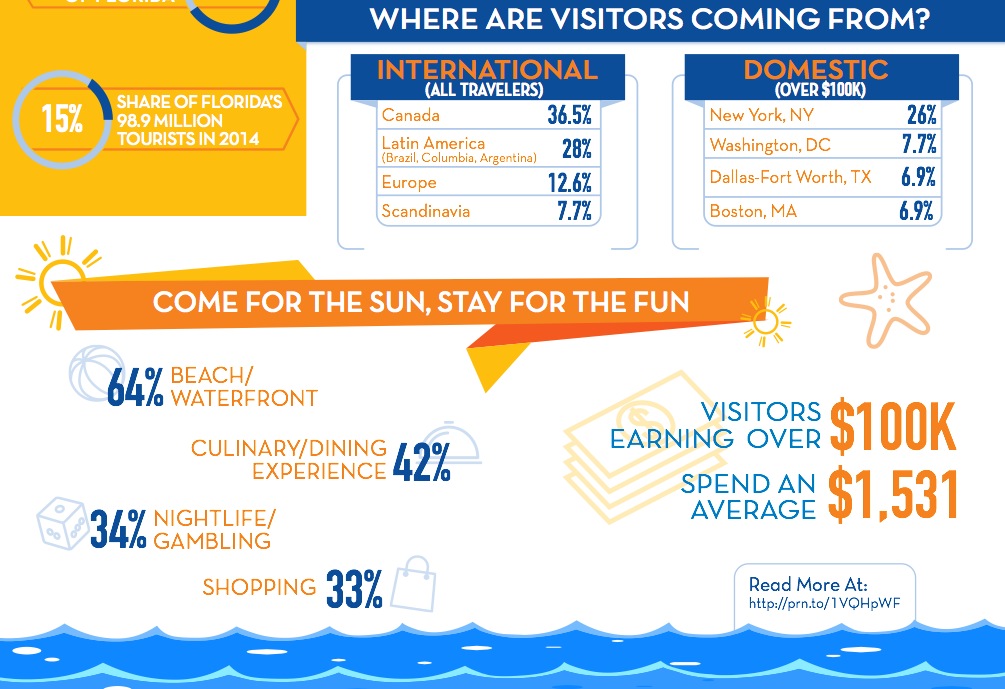A business-financed marketing campaign that began more than seven years ago may have contributed to the surge in construction and development that is transforming Greater Fort Lauderdale in Florida.
More than $1 billion is being invested in new hotel and condo development alone there, with more than $704 million of that development already underway, which will add in excess of 1,000 new rooms and apartments to this market over the next two years. Another $222 million in expenditures for renovations and improvements are earmarked for several hotel properties.
This activity is creating a new landscape of high-rise residential and commercial buildings that is attracting visitors from Washington D.C., Boston, Dallas, and South America.
“By 2030, there are expected to be seven million more Floridians, and South Florida will make up a large part of that growth,” says Bob Swindell, President and CEO of the Greater Fort Lauderdale Alliance, an economic development organization that promotes and markets the advantages of Broward County’s 31 municipalities for business, residential, and tourist interests.

Swindell notes that 2015 was the first year during which the Florida legislature approved funding—$10 million—to market businesses in that county. About one-third of the companies and investors that have projects underway in Broward benefit from publicly funded tax incentives.
New hotel projects include the $200 million Four Seasons Hotel and Private Residences, which is scheduled to open in 2018; the $500 million Auberge Beach Residences & Spa, slated to open in 2017; the $120 million Gale Boutique Hotel & Residences, opening in 2017; and the $40 million Conrad Fort Lauderdale Beach Resort, opening this year.
Also in the works is the $1 billion Metropica mixed-use development in nearby Sunrise, Fla., which when completed within the next seven years will include more than 1,900 condos, 345 apartments, a hotel, 400,000 sf of retail (including 12 restaurants), and 150,000 sf of offices. Construction on the first condos began last October, and is scheduled to begin on the commercial component in the first quarter of 2016.
Plans are underway for a $2.3 billion expansion of the Fort-Lauderdale-Hollywood International Airport. Funding is in place, says Swindell, for a $600 million expansion of the Broward County Convention Center, which would include a new hotel with between 700 and 1,000 rooms by 2019. He adds that this market could soon have sufficient density to support a light-rail system.
“We made a move to buy the building for the Conrad two years ago,” says Andreas Ioannou, a former executive with Hilton Hotels and now CEO of Orchestra Hotels & Resorts, which he formed in 2014. The 24-story Ocean Resort Residences Conrad Fort Lauderdale Beach Resort will have 290 for-sale condos and residences, including 20 oceanfront villas and three penthouses. It has 178 studio apartments that average 640 sf and start in the low $400s.
Even with so much new construction going on, Ioannou isn’t worried about the market overheating. “Exactly the opposite. Fort Lauderdale has very controlled growth at the ocean.” And he’s confident that Greater Fort Lauderdale will continue to be a magnet for homebuyers and businesses from the Northeast, Midwest, Canada, and other parts of Florida, too. “Miami Beach prices are more than double those in Fort Lauderdale,” he says about the cost of apartments in both metros.

Fort Lauderdale’s growth spurt coincides with a nearly 7% increase in this area’s population over the past decade, according to Census Bureau estimates. The University of Florida’s Bureau of Economic and Business Research has estimated that Broward County could expand to 2.46 million people by 2040, from 1.9 million in 2015.
Some 15 million tourists are expected to visit Greater Fort Lauderdale in 2016, including a significant number from South America. “As long as those countries remain OK, they will keep coming to South Florida,” predicts Ioannou.
Swindell believes his organization has played a role in this market’s development boom, starting with a “perception survey” the Alliance conducted in the mid 2000s. That pool revealed that Broward County “did not have much name recognition” and that referring to this market as Greater Fort Lauderdale had more brand equity.
So the Alliance convinced local businesses to invest in a rebranding campaign that played up the market’s plusses, which include its Triple-A bond rating and its low business taxes. The Alliance directed that campaign toward the New York metropolitan area, as well as Chicago and Boston. Since 2008, the Alliance and its business partners have spent more than $6 million on this effort.
On its website, the Alliance identifies the industries that it is tries attract to Greater Fort Lauderdale: Advanced Materials & High Tech Manufacturing, Creative Economy and Film, Global Logistics, Information and Communications Technologies, Life Sciences, and Marine. Last year, the Alliance hired a consultant to make sure it was going after the right sectors (it was, says Swindell). The market has also seen promising growth in the aviation sector, particularly on the maintenance and repair sides.
Other Florida cities, including Orlando and Miami, have their own strategies to get their share of the ongoing influx of people and businesses into the Sunshine State. But Swindell doesn’t see Florida metros as competition with Fort Lauderdale as much as places like Atlanta, Charlotte, and even Panama City.
He makes his pitch to the AEC community by pointing out that a lot of what’s going up in Greater Fort Lauderdale is “architecturally interesting,” and that projects there aren’t just being planned but are also being financed and getting built.

Related Stories
| Oct 28, 2013
Urban growth doesn’t have to destroy nature—it can work with it
Our collective desire to live in cities has never been stronger. According to the World Health Organization, 60% of the world’s population will live in a city by 2030. As urban populations swell, what people demand from their cities is evolving.
| Oct 18, 2013
Researchers discover tension-fusing properties of metal
When a group of MIT researchers recently discovered that stress can cause metal alloy to fuse rather than break apart, they assumed it must be a mistake. It wasn't. The surprising finding could lead to self-healing materials that repair early damage before it has a chance to spread.
| Sep 24, 2013
8 grand green roofs (and walls)
A dramatic interior green wall at Drexel University and a massive, 4.4-acre vegetated roof at the Kauffman Performing Arts Center in Kansas City are among the projects honored in the 2013 Green Roof and Wall Awards of Excellence.
| Sep 19, 2013
What we can learn from the world’s greenest buildings
Renowned green building author, Jerry Yudelson, offers five valuable lessons for designers, contractors, and building owners, based on a study of 55 high-performance projects from around the world.
| Sep 19, 2013
6 emerging energy-management glazing technologies
Phase-change materials, electrochromic glass, and building-integrated PVs are among the breakthrough glazing technologies that are taking energy performance to a new level.
| Sep 19, 2013
Roof renovation tips: Making the choice between overlayment and tear-off
When embarking upon a roofing renovation project, one of the first decisions for the Building Team is whether to tear off and replace the existing roof or to overlay the new roof right on top of the old one. Roofing experts offer guidance on making this assessment.
| Sep 17, 2013
Healthcare project will merge outpatient clinic with YMCA to promote wellness and prevention
Penrose-St. Francis Health Services and the YMCA of the Pikes Peak Region announce collaboration, along with developer The Boldt Company, to create next-generation wellness facility.
| Sep 16, 2013
Study analyzes effectiveness of reflective ceilings
Engineers at Brinjac quantify the illuminance and energy consumption levels achieved by increasing the ceiling’s light reflectance.
| Sep 13, 2013
Loews Hotels & Resorts announces major cross-portfolio upgrades
Loews Hotels & Resorts is currently in the midst of a major growth and property redesign initiative, reflecting a strong national trend in hospitality renovation.
| Sep 11, 2013
BUILDINGChicago eShow Daily – Day 3 coverage
Day 3 coverage of the BUILDINGChicago/Greening the Heartland conference and expo, taking place this week at the Holiday Inn Chicago Mart Plaza.

















